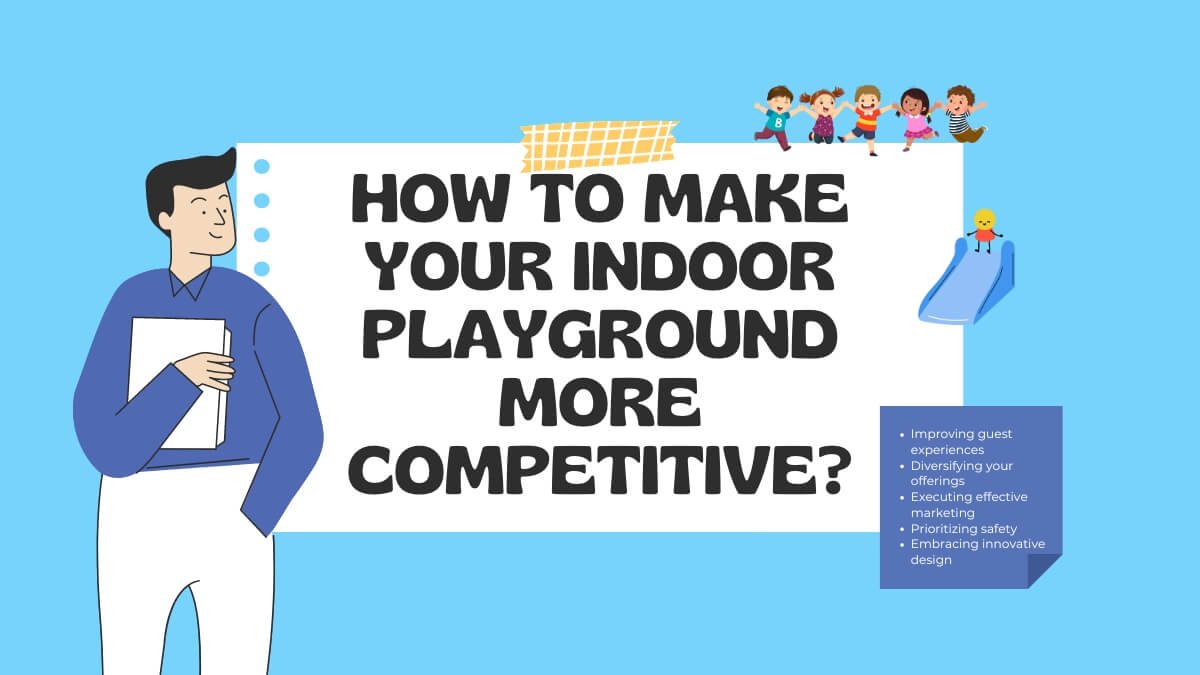As an indoor playground owner, you’re in a tough spot. Families are looking for fun, safe places for their kids to play, but there are so many options. What’s the problem? Parents want the best for their kids. If you can’t deliver an amazing experience, they’ll go somewhere else. How do you turn those problems into opportunities and ultimately get more families to your playground?
To make your playground more competitive, focus on five key areas: improving guest experiences, diversifying your offerings, executing effective marketing, prioritizing safety, and embracing innovative design. By mastering these areas, you can dramatically increase your appeal in a market that’s getting more and more crowded with family entertainment options.

Now that we’ve laid the foundation, let’s talk about some specific strategies that can make your playground more fun for kids and more profitable for you.
Key Strategies to Elevate Your Playground’s Appeal and Profitability

Enhance Guest Experience
- Outstanding Customer Service: Train your team to deliver great service, creating a welcoming environment for families. Friendliness goes a long way in keeping your customers happy and coming back.
- Regular Updates: Keep your play areas fresh by changing out equipment and themes. Add new attractions or rotate what you have to give people a reason to come back if they’ve been to your place before.
- Interactive Elements: Integrate educational and interactive elements like AR features or themed play stations that teach kids while they’re playing.

Diversify Offerings
- Unique Attractions: Set yourself apart by adding unique play structures and activities like ninja courses, climbing walls, zip line, interactive games, or themed environments (e.g., jungle or undersea themes).
- Special Events and Parties: Host themed events, birthday parties, and community gatherings to attract larger crowds. Custom packages can cater to different interests and budgets, boosting your revenue.
- Food and Beverage Sales: When you sell food and drinks, you encourage families to stay longer and spend more money. Think about adding a café or snack bar for parents and kids.

Strategic Marketing
- Visibility and Location: Pick a spot that’s easy to get to and easy to see so people will stop in on a whim. Use bright signs to make your place stand out in busy areas.
- Community Engagement: Partner with local schools and organizations to promote events and activities. Use social media to show off the cool things about your playground and interact with potential customers.
- Special Offers: Create a loyalty program or run promotions for different seasons to get people to come back. Use social media to offer exclusive discounts to your followers.

Focus on Safety
- Compliance with Safety Standards: Follow safety guidelines by making sure all your equipment meets official standards (e.g., ASTM F1918-12, CE, EN71, EN1176). It’s also important to check your equipment on a regular basis to make sure it’s safe.
- Clear Safety Protocols: Create rules for your play areas, including supervision requirements and behavior expectations, to let parents know their kids are safe.

Innovative Design
- Custom Play Structures: Spend money on play areas that are designed specifically for your target customer. Unique designs create memorable experiences that get people talking about your place.
- Flexible Spaces: Design spaces that can host a variety of activities, from open play to structured classes, to serve a wider audience including toddlers, teens, and adults.
What Safety Measures Do Indoor Playgrounds Typically Implement?
Safety is the most important thing at any indoor playground. Owners usually do a few things to keep kids safe:
Design and Construction
- Round edges, comfortable padding, and safe materials on play equipment to minimize the chance of kids getting hurt.
- Enough space between play structures so kids don’t run into each other.
- Impact-absorbing flooring materials like EVA floor mat to keep kids from getting hurt if they fall.
- Independent testing and certification of equipment to make sure it’s safe.
Supervision and Staff Training
- Making sure supervisors can see kids easily.
- Training your staff in emergency procedures, first aid, and how to use the equipment.
- Following a regular schedule for inspecting all the play equipment kids play on.
- Fixing anything that’s broken as soon as you find it during an inspection.
Hygiene and Cleanliness
- Clean and sanitize the play equipment and surfaces on a regular basis to keep your indoor playground healthy.
- Make people take their shoes off and put personal belongings in lockers.
Safety Signs and Guidelines
- Posting clear and visible safety signs throughout the playground.
- Providing informative signs at entrances listing rules and regulations.
- Establishing visitor guidelines specifying safety behavior standards.
Other Safety Measures
- Separate areas for toddlers/preschoolers from areas for older children.
- Do not wear loose clothing, jewelry, or accessories that can get caught in equipment.
- Teach children how to play safely, such as taking turns and sharing equipment.
What Are the Most Common Safety Hazards in Indoor Playgrounds?
Indoor playgrounds, while designed for kids to have fun, can be dangerous if not properly maintained and supervised. Here are the most common safety hazards to be aware of:
1. Lack of Supervision
One of the biggest hazards in any play environment is lack of supervision. When kids are left to their own devices or are watched by untrained staff, the chances of accidents skyrocket. Kids can do stupid stuff and get hurt. Staff should have clear guidelines for supervision, including how to keep an eye on multiple play areas at once.
2. Unsafe Equipment
Play equipment that is not maintained or that is poorly designed can cause a variety of injuries. Equipment with sharp edges, loose parts, or structural weaknesses is dangerous for kids. Regular inspections and maintenance schedules are important to make sure all equipment meets safety standards and is in good working order.
3. Entrapment Hazards
Entrapment occurs when a child gets stuck in a piece of equipment, such as a tunnel or netting. If the openings are too big, a child’s body can go through, but their head can get stuck, which is bad. Making sure all openings are the right size and designed to prevent entrapment is important.
4. Insufficient Spacing Between Equipment
When play structures are too close together, kids are more likely to run into each other. When kids run or jump from one piece of equipment to another, they can accidentally bump into each other, leading to falls and injuries. Proper spacing between structures is important for safe play and easy movement.
5. Lack of Protective Surfacing
Falls are a big cause of injuries on indoor playgrounds. If there is not enough padding under the equipment, kids can get hurt. You need to have cushioned flooring materials, like EVA foam mat, under all play areas to cushion falls and lessen the chance of injury.
6. Unsanitary Conditions
Dirty indoor play equipment can be full of germs and bacteria, which is bad for kids. If equipment is not cleaned and sanitized regularly, it can cause kids to get sick. You need to have a good cleaning schedule and make sure you regularly disinfect all surfaces.
What should you pay attention to when inspecting indoor playground equipment?
Regular inspections of indoor playground equipment are important to keeping things safe and making sure kids have a good time. Here are the things you need to look for when inspecting equipment:
1. Broken, Damaged or Missing Parts
Check all play structures for broken, damaged, or missing parts. Look for cracks in plastic components, bent metal pieces, or loose screws that could cause problems. If you see any damage, replace or repair the equipment right away.
2. Loose Anchoring and Surfacing Issues
Make sure all equipment is securely anchored to the ground. Equipment that is not secured can tip over or move when kids play on it, which is bad. Also, check out the surfacing material. If it is worn down or missing, fix it right away.
3. Netting, Webbing, and Vinyl
Look at netting, webbing, and vinyl components for tears, frays, or holes. This stuff needs to be in good shape to be safe because if it is damaged, kids can get stuck or fall. If you see any damage, replace these components right away.
4. Cleanliness and Sanitation
Make sure all play equipment, surfaces, and common areas are clean and sanitized. Pay special attention to things that get touched a lot, like handrails and where kids enter. Have a cleaning plan that includes regularly disinfecting the equipment, especially when lots of kids are using it.
5. Other Safety Checks
Check for places where kids could get pinched, sharp edges, or rough areas that could cause problems. Make sure all the electronic stuff works and there are no loose wires. Make sure all pads are in good shape, secured and in the right spot.
Conclusion
Improving your indoor playground’s performance is an ongoing process that focuses on guest experience, safety, and innovation. By doing these things, you can create a vibrant, safe, and fun place that families will want to visit. If you’re ready to take your playground to the next level and look at high-quality equipment options, give us a call. We’ll be happy to help. Together, we can help you create the ultimate playground experience!

